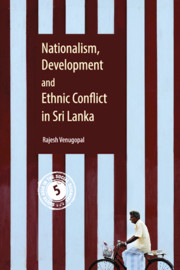Book contents
- Frontmatter
- Dedication
- Contents
- Figures
- Tables
- Preface
- 1 Nationalism, Development and Ethnic Conflict in Sri Lanka
- 2 Sinhala Nationalism
- 3 Kulaks to Clerks
- 4 The Politics of Market Reform at a Time of Ethnic Conflict
- 5 Military Fiscalism
- 6 The ‘Best and Last’ Chance for Peace
- 7 Cosmopolitan Capitalism
- 8 Sectarian Socialism
- 9 Conclusions: Elites, Masses and the Rajapaksa Presidency
- Bibliography
- Index
6 - The ‘Best and Last’ Chance for Peace
Published online by Cambridge University Press: 01 November 2018
- Frontmatter
- Dedication
- Contents
- Figures
- Tables
- Preface
- 1 Nationalism, Development and Ethnic Conflict in Sri Lanka
- 2 Sinhala Nationalism
- 3 Kulaks to Clerks
- 4 The Politics of Market Reform at a Time of Ethnic Conflict
- 5 Military Fiscalism
- 6 The ‘Best and Last’ Chance for Peace
- 7 Cosmopolitan Capitalism
- 8 Sectarian Socialism
- 9 Conclusions: Elites, Masses and the Rajapaksa Presidency
- Bibliography
- Index
Summary
The Context
The Cease-Fire Agreement (CFA) of February 2002, and the peace process that followed, gave rise to unprecedented optimism that the long-standing civil war had finally come to an end (Saravanamuttu 2003, Balasingham 2004, Uyangoda and Perera 2002, Uyangoda 2002, Goodhand et al 2005). With strong public support, and with the strong diplomatic and financial support of the international community, the government of Sri Lanka and the Liberation Tigers of Tamil Eelam (LTTE) engaged in six rounds of direct negotiations, and had reached substantial agreement on critical conceptual issues. By late 2002, a final settlement of the conflict came clearly within sight as the Norwegian mediators announced that both parties had reached a ‘paradigm shift’ in their respective positions, and had agreed on the broad outlines of a future settlement:
[T]he parties have agreed to explore a political solution founded on the principle of internal self-determination in areas of historical habitation of the Tamil-speaking peoples, based on a federal structure within a united Sri Lanka.
The LTTE's chief negotiator, Anton Balasingham, announced that ‘both the parties have made an unprecedented historic decision to work out a political formula for the solution of the protracted ethnic conflict.’ Chief government negotiatior, Professor G.L.Peiris, was equally optimistic, announcing: ‘I think an interim solution can certainly be arrived at in a matter of months rather than years.’ By then, the cease-fire had already held for an entire year, the longest cessation of hostilities since 1983. There remained numerous irritants on the ground level, as well as some clear provocations, but nothing of a scale that could disturb the clear momentum of the peace process. The benefits of peace were so overwhelming and self-evident that it seemed irrational that either side would ever want to return to war. There was a warm relationship and considerable goodwill between the LTTE and government, epitomised by the reported bonhomie that developed between the two chief negotiators. On the ground level, the return to normality was characterised by widespread reconstruction, the return of refugees, the removal of military checkpoints, the de-mining of roads and farmlands, and a general atmosphere of optimism.
But within three years of the euphoric ‘Oslo Declaration’, the peace process had unravelled to the point of complete collapse, and both sides were clearly preparing for a renewed phase of war.
- Type
- Chapter
- Information
- Nationalism, Development and Ethnic Conflict in Sri Lanka , pp. 121 - 138Publisher: Cambridge University PressPrint publication year: 2018

